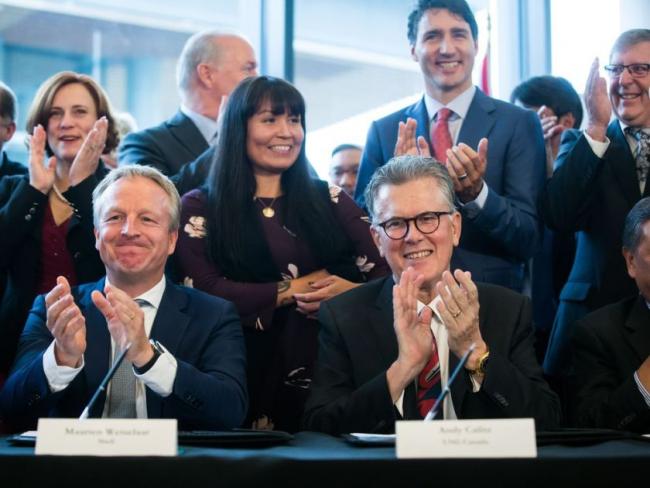Articles Menu

Updated: October 21, 2018
Yes, the development of LNG in B.C. and the LNG Canada project will mean jobs, careers, business opportunities and revenue for First Nations, for First Nations people, and for First Nations communities.
You’ve heard that before, so let me look at LNG Canada’s go-ahead announcement from a slightly deeper angle: The difference that it will make to daily life and economics in our First Nations communities, on and off-reserve.
Let me start with these points:
• Did you know that an Indigenous family in B.C. is lucky to earn half what a non-Indigenous family earns?
• Did you know that Indigenous people in Canada are more than twice as likely to be unemployed than non-Indigenous people?
And did you know that the National Aboriginal Economic Development Board has made these findings:
• If Indigenous peoples had the same education and training as non-Indigenous peoples, the resulting increase in productivity would mean an additional $8.5 billion in income earned annually by the Indigenous population.
• If Indigenous peoples were given the same access to economic opportunities available to other Canadians, the resulting increase in employment would result in an additional $6.9 billion per year in employment income and approximately 135,000 newly employed Indigenous people.
• If the poverty rates among Indigenous peoples were reduced, the fiscal costs associated with supporting people living in poverty would decline by an estimated $8.4 billion annually.
• Overall, if the gap in opportunities for Indigenous communities across Canada were closed, it would result in an increase in GDP of $27.7 billion annually or a boost of about 1.5 per cent to Canada’s economy.
National Chief Perry Bellegarde of the Assembly of First Nations sums up the Canadian picture this way:
• “In 2015, Canada ranked ninth in the world for quality of life, according to the United Nations Human Development Index. If you apply those same principles to Canada’s Indigenous community, that ranking drops to 63rd.
• “This gap represents everything we talk about: it represents the 1,200 missing and murdered Indigenous women and girls; it represents the high youth suicide rate, the 132 boil-water advisories; it represents the cap on post-secondary funding, the disproportionate number of people in jails.”
So I see the green light for LNG Canada as meaning not just jobs and revenue. To me, it means a chance for affected First Nations to take a small step toward narrowing that gap between their standard of living and that of non-Indigenous Canadians, and beginning to deal with a myriad of social problems.
To be clear, I mean ‘a step’ and only a small step. A construction job on the LNG Canada plant, or an environmental-stewardship job on the Coastal GasLink pipeline that will supply it with gas, is not going to miraculously close the gap between nine and 63.
And to maximize this opportunity, much work still lies ahead for skills development, procurement and capacity building for government and communities. We must continue to work collaboratively to make sure the negative impacts are closely monitored and managed and that we do everything we can to make the positive impacts sustainable and meaningful.
If we do it right, short-term jobs can turn into careers, and lifelong careers mean lifelong changes and improvements in standards of living. As the old Chinese proverb says: “A journey of a thousand miles begins with a single step.”
The work and wealth and spinoffs generated by the LNG Canada project and the pipeline will also be spread beyond First Nations, and beyond B.C., too.
The two projects will also generate billions in taxes for all levels of government, and that means support for education and health care and social programs that all of us use, Indigenous and non-Indigenous.
And, since the environment is a primary concern for First Nations people, let’s note that the Resource Works Society finds the LNG Canada project would make B.C. carbon-neutral, and would be like taking 19 million cars off the world’s roads.
Let me close with this thought from Perry Bellegarde, which will be helped by the LNG Canada and Coastal GasLink projects:
‘We’re still here, but we don’t want to be in 63rd anymore. We’ve got to close this gap, which really is in the best interest of Canada.’
Karen Ogen-Toews is a former elected chief of the West’suwet’en First Nation in northern B.C., and is a qualified social worker. The First Nations LNG Alliance that she heads is a collective of First Nations who are participating in, and supportive of, sustainable and responsible LNG development in B.C.
[Top photo: Shell Integrated Gas & New Energies Director Maarten Wetselaar, front left, LNG Canada CEO Andy Calitz, front right, and Prime Minister Justin Trudeau, back right, applaud after a final investment declaration was signed by LNG Canada joint venture participants to build an LNG export facility in Kitimat, during a news conference in Vancouver on Tuesday, Oct. 2, 2018. DARRYL DYCK / THE CANADIAN PRESS]